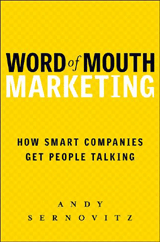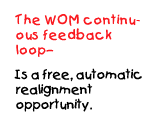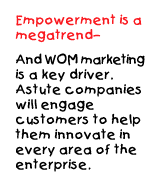Immensely Valuable Field Guide for Word of Mouth Practitioners—with a Twist
 Word of Mouth Marketing is an exceptionally useful, insightful and surprising book. Andy Sernovitz has done a masterful job at creating a brief, lucid and tactical guide to realigning your company’s relationships with your customers, quickly and inexpensively. It is very straightforward, honest and full of practical techniques. Moreover, it is very human because it addresses customers as human beings, not demographics. I suspect that this aspect of the book might peeve those marketers that are invested in the difficulty and complexity of their craft. Think about it: when customers were (relatively) mute and invisible, marketers were the intermediary between the enterprise and the customer; in the absence of the customer’s voice, they created models and theories to simulate it. WOM, powered by Web 2.0, means that customers can talk in their own words, and companies can listen. The customer’s back!
Word of Mouth Marketing is an exceptionally useful, insightful and surprising book. Andy Sernovitz has done a masterful job at creating a brief, lucid and tactical guide to realigning your company’s relationships with your customers, quickly and inexpensively. It is very straightforward, honest and full of practical techniques. Moreover, it is very human because it addresses customers as human beings, not demographics. I suspect that this aspect of the book might peeve those marketers that are invested in the difficulty and complexity of their craft. Think about it: when customers were (relatively) mute and invisible, marketers were the intermediary between the enterprise and the customer; in the absence of the customer’s voice, they created models and theories to simulate it. WOM, powered by Web 2.0, means that customers can talk in their own words, and companies can listen. The customer’s back!
However, this direct customer connection also means that marketing will be much more fun and less frustrating for companies that understand the shift and engage their customers. This direct, fun and productive new reality emanates from the book’s every page, and its energy is infectious. As a business strategy consultant, I cannot overstate the importance of beginning to act on consumer empowerment as soon as possible. I highly recommend the book as a way to change your thinking and develop some practical first steps.
The Twist
Although not its primary goal, the book reflects the emerging presence of the customer’s voice and its profound ramifications for the economy and its players. Because individuals are increasingly able to communicate and interact in a highly scalable digital environment, their voices are magnified, and they can have a greater impact on the enterprise. It is a real conversation on an enterprise scale, and possibilities are endless. Listening to, asking and responding to customers is rapidly becoming an actionable, pragmatic vision that the book clearly reflects. At the same time, the book is surprising and even disconcerting because it reflects how unaligned Industrial Economy marketing is from customer reality.
Book Overview
Part 1: The Essential Concepts
Chapter 1: What Is Word of Mouth Marketing?
The proverbial “level setting” chapter contains the basics:
- The reasons people talk about you: they like you and your stuff; talking makes people feel good; people feel connected
- Never try to “pay” to get WOM
- The five Ts: Talkers, Topics, Tools, Taking part, Tracking
- Ways to stop WOM: I liked this example of overexposure and lack of new material: “Hey, have you heard about The Da Vinci Code?”
- You can’t fake WOM, and you’ll be vilified if you try to deceive. You’ll be found out, and news travels at the speed of light. The “Rules of Honest Word of Mouth” are on point.
My favorite insight from this chapter is that WOM has always had the biggest share of marketing response, but since marketers weren’t looking for it, they didn’t find it. The book points out that WOM has had no budget, so therefore it hasn’t been tracked or recognized. It includes some eye-opening numbers.
Chapter 2: Deep Stuff: Six Big Ideas
- I’ll include these as teasers. Buy the book to get the meat:
- Consumers Are in Control—Get Used to It
- UR the UE (“You Are the User Experience”)
- It’s All About the Permanent Record
- Honesty Is the Essence of WOM
- The Math of Customer Satisfaction (my favorite)
- WOM Makes More Money
 A critical concept: although this is context-dependent, people often believe the advice of other people more than experts or salespeople (“People Like Me”).
A critical concept: although this is context-dependent, people often believe the advice of other people more than experts or salespeople (“People Like Me”).- Another pearl I can’t help repeating: “Success comes not from what you advertise, but from what you deliver.” The performance of offerings in the field now has an instant feedback loop. Reality in the field is everything. And digital WOM is in its infancy.
- “Three Math Problems” are worth the price of the book. They show how WOM plays out when companies are inept:
- Spend six figures on search engine advertising that shows up beside blatantly negative blog postings from people who have been burned.
- A $5 million product launch that doesn’t deliver–spectacularly. Negative reviews show up and snowball. The product doesn’t have a chance, and spillover taints other products.
- Shoddy email tactics permanently anger far more people than the company ever projected to gain, not to mention the investment companies made to piss people off.
- It also makes a convincing business case for WOM.
The book lays out what I call “Consumer Empowerment” for all to see and explains it in a fun and matter-of-fact way. Any individual can strike a chord by publishing a pithy comment on a blog and get millions of readers. Ditto for a corny video on YouTube or a LOL ad-lib overdub of a song as a podcast. Intermediaries provide a massive WOM infrastructure, and reviewing and participating is rapidly becoming inculcated into our culture.
Chapter 3: The World of Mouth Marketing Manifesto
This explains the basic WOM tactics, any of which can drive your company’s top line significantly.
Part 2: How to Do It—The Five Ts in Action
Chapter 4: Talkers: Who Will Tell Their Friends About You?
Dedicated to recognizing, motivating and nurturing “Talkers,” who instigate WOM. How to understand and feed their motivations in a straightforward manner. Here’s a basic outline: identify the right talkers, create a communications channel to reach them regularly, give them topics to talk about, and keep them motivated. Excellent practical advice.
- One takeaway for most marketers will be that talkers are not necessarily the “best customers.” They have some motivation for actively talking about your offer .They are often very well informed, but they may not even be customers.
Chapter 5: Topics: What Will They Talk About?
This is almost funny, but the key insight I take away from Chapter Five is that good topics are “vivid moments of customer experience.” Company marketers often do not understand experience from the customer point of view, and good topics are therefore often surprising. The importance of a customer experience focus is so obvious that most people don’t see it, and therefore it is profound insight. For example, Red Envelope focuses on the experience of gift-giving, not the gift itself. People talk more about the wrapping than the gift.
A powerful point that’s beautifully explained is, “Good Topics Are Organic.” It means that topics arise from an offering’s intrinsic design, essence or features. “Marketing” doesn’t have to put lipstick on the pig. The attribute is noteworthy in itself. Taken to its conclusion, this principle becomes baked into the company’s DNA. Experience means delivery and inherent features.
- The chapter also includes extensive examples and guidelines for managing topics (think “life cycle”).
- Although it doesn’t emphasize this, this chapter includes a kind of adoption curve for WOM:
- Phase One: find a topic you can use today (to drive more business).
- Phase Two: create a campaign that is noteworthy in itself
- Phase Three: become a buzzworthy company
Chapter 6: Tools: How Can You Help the Message Travel?
This chapter is full of helpful tactics. Although you will recognize the chapter topics below, Andy looks at them through the WOM lens, with an eye (sorry, can’t stop) for increasing the WOM impact. Here are some of the key topics:
- The Three Must-Use WOM Marketing Tools:
- Ask people to spread the word
- Put everything in an email
- Put a tell-a-friend link on every page of your website
- A key insight is that you will increase your WOM by asking people to spread the word. “Volunteers need to be asked to volunteer.”
- Promotions that are WOM-friendly
- The new matchbooks
- Blogs’ role and opportunities
- Online communities and social media
- Exclusivity, secrets and surprises
- Build it to be stolen
- Testimonials
Chapter 7: Taking part: How Can You Join the Conversation?
This topic is at least a whole book in itself, but this chapter is its alphabet. The WOM world is so innately human that it is largely invisible to us. Today, large organizations are not human-scale, and employees have been conditioned to toe the company line. In most cases, to be effective in the WOM setting, you have to be individual. You always have to be honest. We are each one person in the conversation. This chapter represents the “bullet points” of how to act in this “new” environment. Select highlights:
- Do not be a “corporate spokesperson”
- The worst thing you can do is not participate
- Companies’ greatest fear is negative comments, which are almost always demands for attention—and invitations to fix problems.
- Basic guidelines of dealing with negative comments. Useful tactics but even more so as another view into the whole concept of being open and honest. Once you realize that honesty and openness are rewarded, the context of “negative comments” changes; it becomes much less scary because it’s a part of honesty. Most important, people generally reward honesty and openness.
I have to repeat this:
- For every person whom a happy customer talks to…
- An unhappy customer tells five people
- A formerly unhappy customer who is made happy tells 10 people
The conclusion is obvious: find as many unhappy people as you can, and try to make them happy. Of course, there are some people who really don’t want to be happy, but that’s another story (and they are in the minority).
Chapter 8: Tracking: What Are People Saying About You?
This is a very short, useful chapter for finding “the conversation” of which your company should be a part. It’s happening right now, so go out and participate.
- Measurement ideas. For more, see womma.org/research/
- Online tracking tools
- Encouraging feedback
- Listening to Tell-a-Friend forms and message boards
- Sharing direct mail
- Measuring the Net Promoter Score
- And, my favorite, computing the ROI of WOM
 And in the End…
And in the End…
- Sixteen Sure-Thing, Must-Do, Awfully Easy World of Mouth Marketing Techniques
- Choose to Be Good
- Afterword: Yet Another Top 10 by Guy Kawasaki
Key links
- Book website features other books and blogs on WOM
- Amazon.com
- Word of Mouth Marketing Association
Analysis and Conclusions
Word of Mouth Marketing
- Word of Mouth Marketing is a field guide to WOM for practitioners, not WOM experts. Moreover, it is engaging and well organized, and you can read it in 3 hours. It is full of practical tactics, but there are model-changing insights as well, if you’re willing to entertain them.
- The book has two main value propositions:
- Tactical: simple, specific and impactful methods to increase sales and avoid major gaffes that are regularly practiced by marketers of all stripes. SMBs (small/medium businesses) and large companies will find countless techniques that can help them to drive the top line by making customers happier. Most of them can be implemented fairly easily.
- Strategic: although not the main point, the book reflects the immense importance of consumer empowerment and how it is unfolding. Related to this, it gives glimpses into key online developments. True, WOM happens mostly offline, but it is most obvious online, and the online portion is growing rapidly. The force of online WOM is revolutionary because the impact is greatly magnified—and becoming more so with each passing month.
- Many of the points are deceptively simple, but executing them well consistently will require organizational change at most companies. The good news is, the tactics themselves are simple, and many have fairly short and straightforward ROIs.
- *”Word of mouth” as a distinct practice is immensely useful because it is a rallying cry to get people to return to their roots (before the advent of “marketing” in the 20th century, WOM was all we had). The customer’s voice was heard in the small shops and markets that comprised commerce at the time.
- WOM will eventually disappear, as “e-business” vanished, because it will become the de facto marketing standard. Current marketing practices will continue to add to customer communications, but they will be transformed and remixed.
- People believe other people because, typically, they have similar points of view to the buyer’s. A person, whether s/he made the buying decision recently or some time ago, will have a higher probability of addressing the concerns that are in the buyer’s mind. It’s instant cred, especially when the buyer sees 3-5 reviews that address the key concerns and have similar reactions to the offer.
- “Experts” are abstracted away from the user experience that the buyer will have, and their advice, although often invaluable, will often be incomplete. Giving customers access to both is best practice.
- I agree with Sernovitz that WOM has been around forever and that most of it takes place offline. However, our rapidly developing P2P messaging infrastructure facilitates knowledge exchange, and this is massively scalable when compared to anything we’ve ever seen before. Offline WOM has never been very scalable.
- As adoption of Web 2.0 proceeds, most WOM trends will be orders of magnitude more powerful than they are today.
- “Marketing” as a profession coalesced during the twentieth century in which advanced industrial economies’ production began to outpace consumption in many key areas. Moreover, the Industrial Economy’s defining business principle, “We have huge infrastructure investments that only make sense when we produce a huge amount of the same product,” necessitated “marketing” because products (later services as well) needed to be differentiated, and the process had to be enterprise scale. This is now “Industrial Economy baggage.”
- In the Knowledge Economy, customer experience is where differentiation will be won. Sernovitz crystallizes this in a simple, actionable way (delivery is everything, UR the UE).
WOM and Consumer Empowerment
- Companies became seriously unaligned with their customers during the Industrial Economy, which has nonetheless produced unprecedented wealth by mechanizing the making of things. However, it has caused the resultant companies to focus on the customer second, in favor of managing their large, complex operations. For more, see Retrofitting GM, the Quintessential Industrial Economy Enterprise.
- Consumer empowerment is a megatrend of which WOM marketing is a key driver. Astute companies will eventually engage customers to help them innovate in every area of the enterprise, but, among corporate functions, marketing and customer service will feel the shift first. In being the two key “customer facing” corporate functions, they have the opportunity to transform how the enterprise interacts with customers, and this means diving into WOM and consumer empowerment. For more on this, see Consumer Empowerment—The Opportunity of the Century.
- Marketers who embrace empowerment will find that their results will improve by orders of magnitude, and their jobs will become far more fun and rewarding. To succeed in the transformation, however, they will have to confront conventional wisdom and assumptions that no longer hold true. For more on this, see How the Knowledge Economy Will Transform Markets and the Producer/Consumer Relationship.
- The WOM continuous feedback loop is a free, automatic realignment opportunity. We all know this: companies and governments—due to their “organizational realities” (stock price, system dis-integration, etc. ,^)—do absurd things, and they repeat them even as they know those things frustrate customers and constituents. Their inflexibility prevents them from responding to customers or constituents, but ongoing I.T. advances are enabling far more organizational agility.
- While reading the book, I was struck by the realization that “marketing” was another excellent example of Hegel’s conception of history (bear with me a minute ;-), which specifies this repeating pattern, thesis-antithesis-synthesis.
- This is how it works: A prevailing condition, habit or way of life is a “thesis” which encounters an opposing condition/habit (the antithesis) and the confrontation resolves itself into a “synthesis.”
- Word of mouth was the thesis, pre-Industrial Economy. Professional services still largely operate under the premise of “Do good work, and additional business will come” (due to WOM).
- The industrial enterprise’s need to increase demand in step with increased productivity was the antithesis. Marketing and customer service policies were attempts to reconcile customer desires with organizational needs and limitations. Marshall Fields’ “Give the lady what she wants” has faded with the enterprise’s increased complexity and inflexibility.
- Modern WOM is the synthesis: back is truthfulness and “people like me,” but we have the tremendous scale of industrial-type technology.
- The essence of “Word of mouth” is sharing—and learning from—customer experience. “Consumer” empowerment will also empower producers who collaborate with customers because they will produce unprecedented value.

[…] is imbued with high trust, common understanding/point of view and similar motivations. Until recently, word of mouth was invisible to brands and marketing professionals because it was analog; it […]